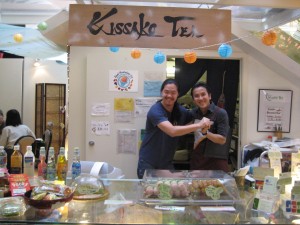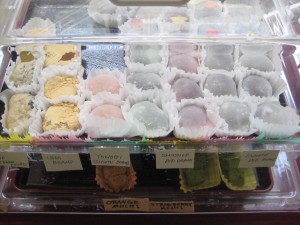To start off, if you are ever hungry and craving for some Japanese cuisine go to St.Marks. The ramen/sushi restaurants are delicious, cheap, friendly, and completely authentic. They are satisfying to the taste buds of any person wanting Japan’s well-known dishes. With St.Marks already being popular for their clothing stores and tattoo/piercing parlors; Japanese food is another reason for that.
Japadog
30 St Marks PL (between Cooper Sq & Astor Pl) New York, NY 10003
646.476.2324 http://www.japadog.com/newyork_En.html
The Japanese restaurants are more or less the same in St.Marks but Japadog is worth highlighting because it is not your typical Japanese food in New York City. Instead of ramen, udon, or sushi they serve hot dogs. Yes, hot dogs. What makes it so special and oh so mouth watering is that they top it off with yakisoba, teriyaki sauce, kimchi, or have edamame inside the hot dog. They have various combinations on their menu that will make you want to try each one. Along with it you can order fries as well but then, once again, you will have to make a difficult decision of what flavor you want. Butter & shoyu flavored fries are amazing but they also have more “daring” flavors like shichimi and garlic, curry, or wasabi. And if you are in the mood for something sweet after the meal you can order the “Ice Age” which is a deep fried bun filled with ice cream with many different flavors. Your stomach should be growling by now so go and head to Japadog.
Otafuku
236 E 9th St (between 2nd Ave & Stuyvesant St) New York, NY 10003
212.353.8503 http://otafukunyc.com/
It looks like a typical Japanese storefront. Everyone has to eat outside because of it’s small size. They are most popular for their takoyaki. It’s freshly made all day long and is an absolute treat when I stop by. They are perfectly chewy and savory and for all I know Otafuku makes the best takoyaki in the city. Not to mention that the food is cheap so you can buy a lot of takoyaki and drink some Ramune as well.
Sushi Park
121 E 2nd Ave (between 7th St & St Marks Pl) New York, NY 10003
212. 533.8448
50% off sushi. Yes, this restaurant is a favorite for me and my friends because we don’t have to pay a lot but we still get quality sushi. Their sushi selection is huge, so do expect discovering new flavors that will make you come back for more. I always tend to order Godzilla sushi roll because it’s fried and have a bunch of things rolled in to it. Everything is delicious and I recommend it if you ever stop by. Plus during lunch time they have $1 appetizers which I always take advantage. For example, I get edamame or dumplings. Right next to the restaurant, there is also a good spot for 50% ramen. It just depends what you’re in the mood for. Both restaurants will not disappoint any Japanese cuisine lover.


 .
.














































